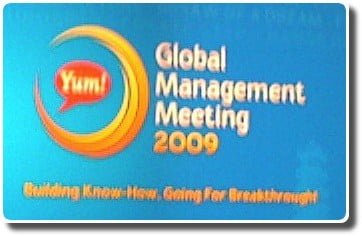 I was thrilled to be the opening keynote speaker for Yum! Brands 2009 Global Leadership Meeting. It’s the world’s largest restaurant company.
I was thrilled to be the opening keynote speaker for Yum! Brands 2009 Global Leadership Meeting. It’s the world’s largest restaurant company.
The organization, the owner of such iconic brands such as KFC, Taco Bell and Pizza Hut, certainly finds itself in the midst of high-velocity change. There are fast paced trends in terms of new branding challenges and marketing methodologies (think Web 2.0), consumer behavior, and many other issues. Yet, there are tremendous opportunities for growth through innovation.
My keynote addressed a variety of trends which are impacting the QSR (quick service restaurant) industry today:
- opportunities for global growth. Chain restaurants account for but 1% of China’s commercial food service sales, and in Europe, it is but 2%. (Compare that to the US, which is at 50%.) Clearly, growth will come from continued expansion into global markets.
- rapid emergence of new methods of customer interaction. For example, in the next few years, we will likely see the emergence of contact-less payment technology, as our credit card infrastructure migrates to Blackberry, iPhone, and smart phones. This presents new opportunities in terms of customer contact.
- new methods of brand and product promotion. Organizations must be able to scale to meet the demands of new intelligent infrastructure, and that will require a tremendous amount of innovation. Consider text messaging: Subway is working with a “pRomo” program that provides for remote retrieval of mobile coupon offers. With 147 million people already interacting globally on social networks via their mobile phones, there are tremendous opportunities for new methods of achieving brand and product awareness.
- rapid change in consumer choice. Take the issue of health concerns and balanced diet. Fresh-cut snack foods grew from $6.8 billion in to $10.5 billion in a short time, according to the International Fresh-Cut Produce Association. Innovation comes from changing product mix to keep up with fast-changing consumers.
- rapidly emerging new menus and taste trends. It’s estimated that new flavors now move from upscale kitchens to chain restaurants in 12 months, compared to 36 months 5 years ago. This means that faster innovation is not a luxury – it’s a necessity. Change faster, and you’ve got new growth-based products.
- fast emerging industry issues. Consider the “greening of the industry.” The Grille Zone, a restaurant chain in Boston, generates about 15 pounds of waste per restaurant, compared to an industry average of 275 pounds. The Green Restaurant Association took 14 years to go to 90 restaurants; it’s now at close to 1,000, with thousands more going through the certification program. Growth can come from evolving a brand so that it matches the social desires of the customer base.
What I stress at events like this is that organizations need to realize that innovation isn’t just about “big innovation” — the launch of new products and services. There’s also the issue of “fast innovation” — in which success is defined by the ability of the organization to respond to rapidly changing products, markets, business models, economic trends, competitive moves, consumer trends and just about everything else. Innovation today is moving from more than just “products” to process, structure, capability, and speed.
Is the industry innovating? You bet: in October 2008, the US QSR market saw the biggest number of “Limited Time Offers,” a unique method of increasing sales, with 547 new menu items (up 40% from the prior year. Noted Obesity, Wellness, Fitness Week magazine in November 2008, “operators appear quite open to partnering with suppliers on new products with shorter lead times.”
Here’s the thing: in my keynotes, I focus on growth opportunities. There are enough people out there who are so focused on the doom and gloom of the economy, that they lose sight of the fact that if they focus on fast innovation — and keeping up with rapid trends — they can discover all kinds of new ways to grow the business.
Faster is the new fast. Think growth. Think innovation.




GET IN TOUCH
Jim's Facebook page
You'll find Jim's latest videos on Youtube
Mastodon. What's on Jim's mind? Check his feed!
LinkedIn - reach out to Jim for a professional connection!
Flickr! Get inspired! A massive archive of all of Jim's daily inspirational quotes!
Instagram - the home for Jim's motivational mind!